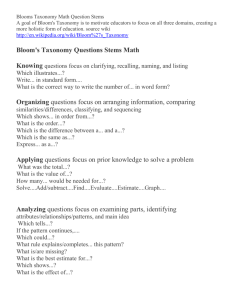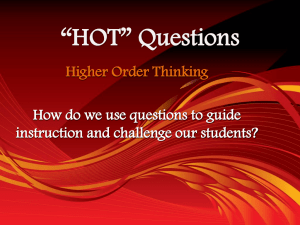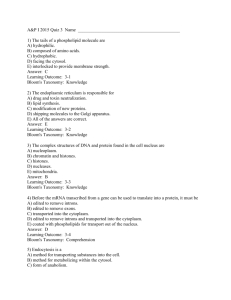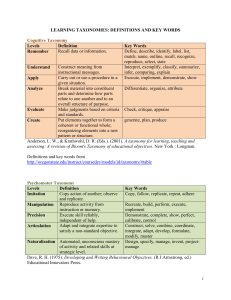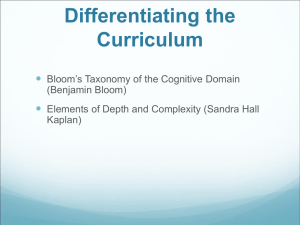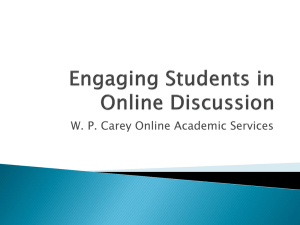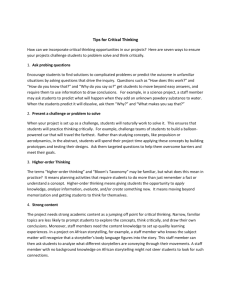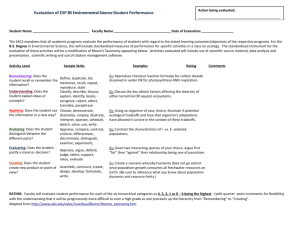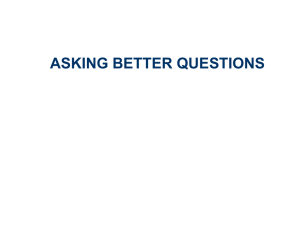Language-learning task design: Using higher
advertisement
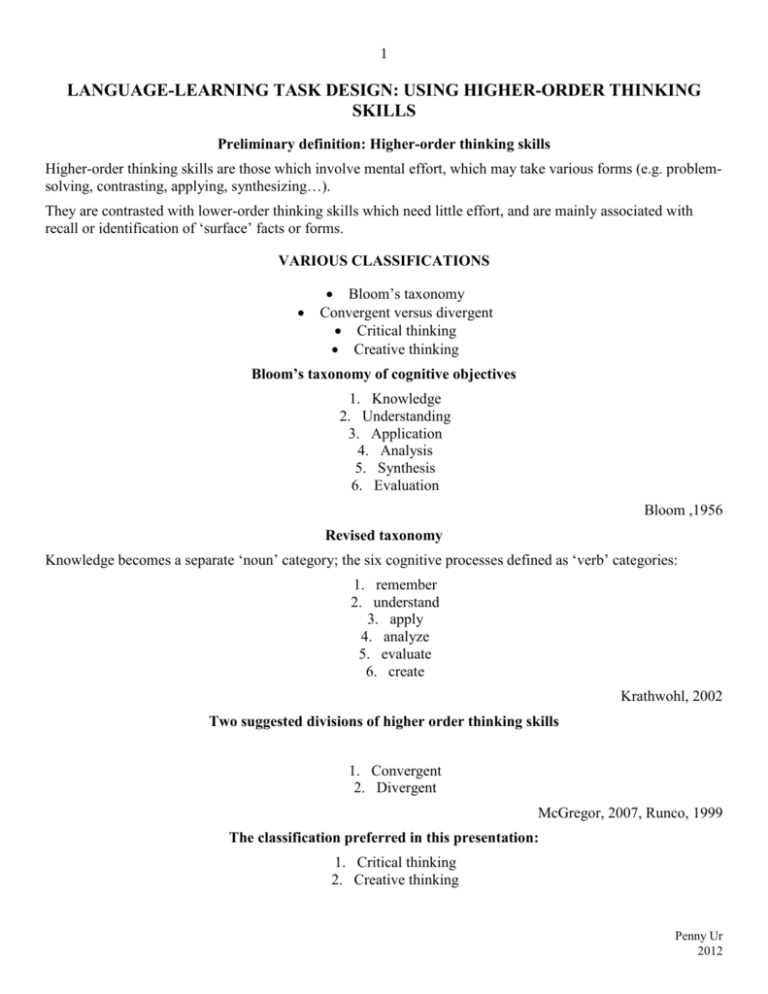
1 LANGUAGE-LEARNING TASK DESIGN: USING HIGHER-ORDER THINKING SKILLS Preliminary definition: Higher-order thinking skills Higher-order thinking skills are those which involve mental effort, which may take various forms (e.g. problemsolving, contrasting, applying, synthesizing…). They are contrasted with lower-order thinking skills which need little effort, and are mainly associated with recall or identification of ‘surface’ facts or forms. VARIOUS CLASSIFICATIONS Bloom’s taxonomy Convergent versus divergent Critical thinking Creative thinking Bloom’s taxonomy of cognitive objectives 1. Knowledge 2. Understanding 3. Application 4. Analysis 5. Synthesis 6. Evaluation Bloom ,1956 Revised taxonomy Knowledge becomes a separate ‘noun’ category; the six cognitive processes defined as ‘verb’ categories: 1. remember 2. understand 3. apply 4. analyze 5. evaluate 6. create Krathwohl, 2002 Two suggested divisions of higher order thinking skills 1. Convergent 2. Divergent McGregor, 2007, Runco, 1999 The classification preferred in this presentation: 1. Critical thinking 2. Creative thinking Penny Ur 2012 2 Critical thinking Wikipedia definition: ‘Critical thinking is the process of thinking that questions assumptions. It is a way of deciding whether a claim is true, false; sometimes true, or partly true. ….Critical thinking is … a part of the education process and is increasingly significant as students progress through university to graduate education, although there is debate among educators about its precise meaning and scope.’ It includes: Analysis: being able to distinguish between categories, generalize, exemplify etc. Precision: being aware of imprecision (vague, contradictory or tautologous statements) in input, and taking care to be precise themselves. Logic: being aware of illogical reasoning in their reading and listening, and able to think logically themselves Criticism: being able to to apply criteria in order to evaluate Creative thinking The ability to think up original solutions to problems; to create new constructs, interpretations or works of art It includes: Divergent thinking: brainstorming a large number of responses to any cue or task Original or ‘lateral’ thinking: devising original, unconventional responses to problems or tasks (De Bono, 1967) Link to other classifications Critical thinking: In the revised Bloom taxonomy: mainly understanding, applying, analysing and evaluating Mainly convergent thinking. Creative thinking Revised Bloom taxonomy: mainly creating. de Bono: ‘lateral’ thinking Mainly divergent thinking REASONS FOR USING HIGHER-ORDER THINKING IN LANGUAGE TEACHING Language learning New language items are better imprinted on our memory if we use deep processing. This means relating the item meaningfully to its meanings and to other items previously learnt. Deeper processing involves higher-order thinking skills: connecting, contrasting, creating etc. (Waters, 2006) Intellectual development The learning of facts and concepts.+ the ability to relate these to each other, criticize, draw conclusions, create new ideas etc. Penny Ur 2012 3 Educational values The ability and willingness to think for oneself, as distinct from the unthinking acceptance of facts, values, directives etc. laid down by an authority. Interest Activities based on simple recall or knowledge of isolated forms and meanings tend to be boring. Activities based on higher-order thinking skills are likely to be more interesting. CRITICAL THINKING 1: ANALYSIS Vocabulary exercises Lower-order thinking skills: gapfills, matching etc. Example: A. A rooster 1. B. A sheep 2. C. A rabbit 3. D. A cat 4. E. A dog 5. F. A duck 6. In contrast, using critical thinking skills (classifying) a clock, a dog, a dress, a mother, black, a pen, bread, pants, a bag, a frog, red, boots, a cat, rice, a man, a baby, pink,a teenager, a hat, a t-shirt, a banana, a book, a sheep, meat, kids, a table, green, an elephant, sugar, white animals colours things food clothes people Penny Ur 2012 4 At a higher level: 1. angry a. unhappy and angry because someone has something you want 2. sad b. feeling pleasure or satisfaction 3. jealous c. lacking interest or energy 4. confident d. having a strong feeling against someone / something that makes you want to shout or hurt them 5. tense e. unhappy or sorry 6. doubtful f. nervous, anxious, unable to relax 7. apathetic g. uncertain about something 8. happy h. sure or trusting In contrast (application to a real-life situation, logical relations) Complete any three 1. I felt angry because… 2. I felt sad although… 3. I felt jealous when … 4. I felt confident so … (Generalizing) 5. 6. 7. 8. I felt tense although … I felt doubtful because … I felt apathetic so … I felt happy when … 6. 7. 8. 9. December winter biology tennis – What classes do the following belong to? 1. 2. 3. 4. 5. a hammer – a tool sadness – a table a mother a palace - Grammar exercises Gapfill, sentence-completion items Relative pronouns (conventional exercise) 1. Stratford is the town ____ Shakespeare was born in. a. a. where b. which c. Either could be used here. 2. The hotel ____ we stayed was good. a. a. where b. which c. Either could be used here. 3. The man ____ interviewed me seemed friendly enough. a. a. who b. which c. Either could be used here. 4. The British Prime Minister, ____ was interviewed yesterday, denied responsibility. a. a. who b. that c. Either could be used here. 5. The car ____ was stolen belonged to my partner. a. a. which b. that c. Either could be used here. 6. The house ____ they have rented is in the centre of town. a. a. which b. - c. Either could be used here. Penny Ur 2012 5 In contrast (logical analysis and exemplification) Define the following items using relative clauses: Example: A hammer is a tool which… 1. a cow 2. Canada 3. a chicken 4. a carpenter (Generalizing) 5. 6. 7. 8. cigarettes coffee a cinema Christmas Here is a list of sentences. 1. We have been working here for a long time. 2. They have been in the country since 1995. 3. The program has been going on for ten minutes. 4. I have loved this singer since the beginning of her career. 5. We have been studying English for four years. 6. She has lived in Haifa since she got married. When do you use since and when do you use for? CRITICAL THINKING 2: PRECISION Inherent contradiction Do these make sense? 1. an objective opinion 2. a definite maybe 3. an exact estimate 4. the larger half 5. genuine imitation leather (vocabulary, critical reading) Tautology What’s wrong with these? 1. 2. 3. 4. 5. A free gift A new innovation. We made too many wrong mistakes He exaggerated the situation too much. It’s pure undiluted orange juice. 6. 7. 8. 9. Let’s meet together at six. It’s a biography of Kipling’s life. That is a basic and fundamental fact of life. They commute back and forth every day. (vocabulary, critical reading) CRITICAL THINKING 3: LOGIC Underlying assumptions What assumptions or emotive implications underlie these statements? 1. 2. 3. 4. 5. This food is composed entirely of natural ingredients, so it is good for you as well as being delicious. This method is scientifically proven to be effective Thousands of people have already signed up: join now! Don’t use this method: it is based on outdated, old-fashioned ideas. Everyone knows that the earlier you start learning a language the more successfully you will master it. (critical reading, writing) Penny Ur 2012 6 What’s wrong with these? 1. These people drink a lot of red wine and have few heart problems: so drinking red wine is good for your heart. 2. The boy told me he’d left his book at home, but it was in fact in his bag: so he was lying. That shows he is a liar. 3. The word ‘education’ comes from a Latin word meaning ‘to draw out’, so education is about drawing out people’s potential. 4. The roads in Israel are not very good, and there are a lot of traffic accidents; that shows that traffic accidents are caused by bad roads. 5. She spends a lot of time reading, so she reads very well. (critical reading, writing) Ambiguity What’s wrong with these sentences? 1. 2. 3. 4. 5. We need more comprehensive schools. Visiting relatives can be boring. Ambulance man helps dog bite victim Enraged cow injures farmer with ax Juvenile court to try shooting defendant 6. Stolen painting found by tree 7. Two sisters reunited after 18 years in checkout counter 8. Kids make nutritious snacks (linguistic awareness, contrastive analysis) Evidence-based conclusions What would be your conclusion from this evidence? 1. 2. 3. 4. 5. 6. She’s wearing a white coat. She’s wearing a stethoscope round her neck. I saw her examining a patient. In her office there’s a certificate that says she graduated from medical school. She was interviewed on television about a disease. There’s a notice outside her door that says ‘Dr Smith’. Conclusion: “She must be a doctor.” (grammar: must/ can’t of logical necessity) Coherence, logic Insert an appropriate conjunction: because / since, although/in spite of the fact that, so/therefore, but/however/nevertheless, and, moreover/in addition, if / provided that 1. She is a good teacher … she hasn’t had much training. 2. I know they are here… I saw them a moment ago. 3. She has ten children … she still has time to write books. 4. He is a good boss … he has a sense of humour. 5. We will come … we get an invitation. 6. We will certainly come … we have plenty of time. 7. He’s lived in the US all his life… he must know English. 8. He is a good speaker … I don’t like him very much. 9. There isn’t much water in the desert … not many plants can grow there. 10. It seems there’s plenty of time … we need to get started immediately. Penny Ur 2012 7 CREATIVE THINKING 1: DIVERGENT THINKING How many things can you think of to say about this picture? (oral fluency) How many ways can you think of to solve this dilemma? (oral fluency) How many ways can you think of to compare a train with a car? (comparatives) How many endings can you think of for the sentence: If I had a million dollars…? (conditionals) How many ways can you think of to use an empty tin can? (A pen? A piece of plasticine?) (oral fluency, can/could) How many adjectives can you think of to describe the noun road? movie? song? (grammar: adjective-before-noun, vocabulary) How many nouns can you think of that could be described by the adjective clear? (hard? black?) (adjective-before-noun, vocabulary) CREATIVE THINKING 2: ORIGINALITY, ‘LATERAL’ THINKING Think of ten ways to compare a computer with a piece of spaghetti. Find six questions to which the answer is …twelve…(tomorrow …of course! …my mother …) Suggest at least three advantages of being an only child? (Of not having a cellphone? Of having no car?) Name ten things you have never done. Name six things that you can’t touch, and why. Say six negative things about …a pen … a cat … English. Say four NICE things about your friend, using negative sentences. SOME CONCLUDING COMMENTS There is no strict dividing line between lower- and higher-order thinking skills: tt’s a continuum. The use of higher order thinking skills in language teaching materials contribute to good learning, and are important. However, knowledge of facts and lower-order thinking skills are basic and essential. It is easier to implement higher-order thinking skills in more advanced materials in the upper grades. However, it is just as important, and perfectly feasible, to implement them in beginner and intermediate materials, or in courses for elementary and middle school. Discussion questions What is the optimum combination of lower- and higher-order thinking skills in teaching materials? In form-focused tasks (grammar, vocabulary etc.)? In communicative tasks (the four skills)? Penny Ur 2012 8 References Bloom B. S. (ed). (1956). A Taxonomy of Educational Objectives. New York: Longman. De Bono, E. (1967). The use of lateral thinking. Harmondsworth: Penguin. Mcgregor, D.. (2007). Developing thinking, developing learning: A guide to thinking skills in education. Maidenhead, Uk: Open University Press: McGraw-Hill International. Krathwohl, D. R. (2002). A revision of Bloom's taxonomy: An overview. Theory into Practice, 41(4), 212-218. Runco, M. A.. (1999). Divergent thinking. In Runco, M. A., & Pritzker, S. R. (Eds.), Encyclopedia of creativity, Volume 1 (pp.577-582). San Diego: Academic Press. Waters, A. (2006). Thinking and language learning . ELT Journal, 60(4), 319-327. Penny Ur 2012
